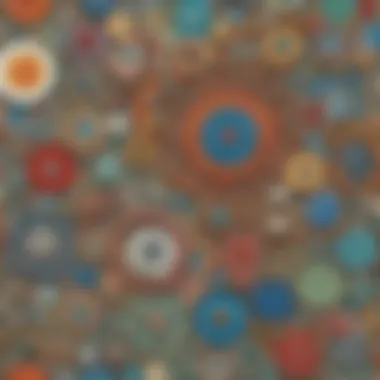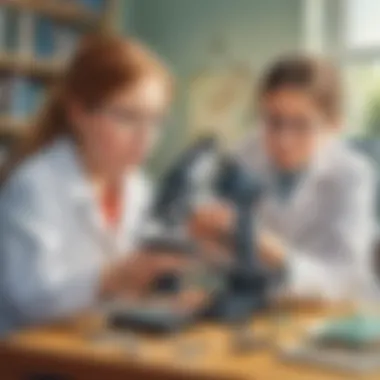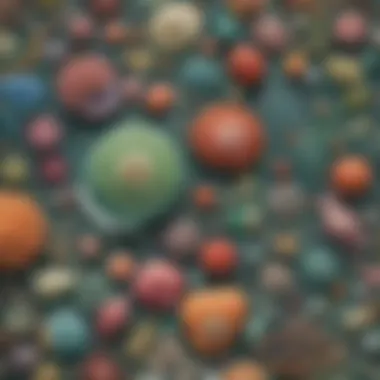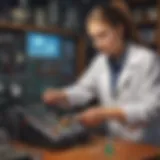Engage Young Minds with Microscope Activities for Elementary Students


Science Fun Facts
Microscopes have a long and fascinating history, dating back to the 16th century when the first primitive versions of these optical devices were invented. Did you know that the compound microscope, which uses multiple lenses to magnify small objects, opened up a whole new world of exploration for scientists and laid the foundation for modern microbiology? Fun Fact: Antonie van Leeuwenhoek, a Dutch scientist considered the 'Father of Microbiology,' was among the first to discover microorganisms using a simple microscope he designed himself. Amazing Science Records: The most powerful electron microscopes available today can magnify objects up to 10 million times their original size! Imagine the incredible detail and precision this technology offers in exploring the microscopic universe.
Discover the Wonders of Science
Exploring Various Scientific Concepts: By delving into the microscopic world through hands-on activities, elementary students can grasp fundamental scientific principles such as magnification, reflection, and refraction. Educational Videos and Animations: Supplementing microscope experiments with visual aids can enhance children's understanding of complex concepts and make learning more interactive and enjoyable. Interactive Learning Tools: Online interactive platforms like virtual microscopes and biology simulations can provide a dynamic and immersive learning experience for young learners. Real-Life Applications of Science: Understanding the world at a microscopic level can pave the way for diverse real-world applications, from medical research to environmental studies.
Science Experiment Showcase
Fun and Engaging Experiments: From observing the structure of a leaf to exploring the cellular composition of everyday substances, hands-on experiments enable students to apply scientific concepts in a practical setting. Step-by-Step Instructions: Clear and concise instructions guide elementary students through each experiment, fostering independence and critical thinking skills. Materials List: Basic laboratory supplies like slides, cover slips, and sample specimens are essential for conducting successful microscope experiments. Safety Tips and Precautions: Prioritizing safety in science activities is paramount; teaching children proper handling and care of microscope equipment ensures a secure learning environment.
Introduction
In this section, we embark on a fascinating journey into the microscopic world, an integral part of science education for elementary students. Understanding the intricacies of the unseen realm through a microscope is not only educational but also mind-expanding. Through hands-on experiences, young learners are introduced to a whole new dimension of discovery, where tiny organisms and structures reveal their secrets under the lens. The importance of this section lies in laying the foundation for future scientific exploration and nurturing a sense of curiosity that will serve students well beyond the classroom.
Understanding the Microscopic World
Introduction to Microscopy
Delving into the realm of Introduction to Microscopy opens up a world of minute details and hidden wonders for students to explore. Introducing microscopy provides a tactile and visual learning experience, allowing children to witness the magnified beauty of specimens that are otherwise invisible to the naked eye. The key characteristic of Introduction to Microscopy is its ability to unveil the hidden microcosm, enhancing students' observational skills and instilling a sense of wonder about the natural world. Despite the complexities it may entail, Exposure to Introduction to Microscopy greatly enriches students' scientific literacy.
Importance of Microscopes in Science Education


Examining the significance of compelling considerations regarding Importance of Microscopes in Science Education unravels the pivotal role microscopes play in fostering a deep understanding of scientific concepts. An area keenly embraced by educators, the methodology behind Importance of Microscopes in Science Education serves to bridge the gap between theoretical knowledge and practical application. This integration is key to enhancing students' critical thinking skills and igniting a passion for scientific inquiry. The requisite tools and techniques encapsulated in anspiracy of Importance of Microscopes in Science Education provide a gateway to a profound appreciation of the natural world.
Basic Components of a Microscope
Unpacking the Basic Components of a Microscope allows students to familiarize themselves with the intricate machinery that brings the microscopic world into focus. Each element of the microscope contributes to the overall functioning, culminating in a magnified view of specimens that captivates young minds. From lenses to light sources, students gain an understanding of the integral parts and their significance. Despite occasional challenges posed by the technical aspects, mastering the Basic Components of a Microscope equips students with a foundational knowledge crucial for further exploration in the scientific realm.
Exploration Activities
In this ind-depth section on Exploration Activities, we delve into the vital role they play in the world of microscopy education for elementary students. These activities are the cornerstone of hands-on learning, fostering a deep understanding of the microscopic realm. By engaging in exploration activities, students get the chance to apply theoretical knowledge to practical experiments, enhancing their scientific curiosity and analytical skills. These activities not only provide a fun and interactive learning experience but also help students develop critical thinking and observation skills essential for future scientific endeavors. The Exploration Activities section serves as a gateway to unlocking the mysteries of the microscopic world and instilling a lifelong love for scientific exploration.
Observing Prepared Slides
Preparing Slides for Observation
Within the realm of science education, preparing slides for observation holds immense significance. It allows students to actively participate in the scientific process by preparing slides themselves, thereby gaining firsthand experience in sample preparation and microscope usage. The key characteristic of preparing slides for observation lies in its ability to transform theoretical knowledge into tangible visual data. This practical activity enables students to understand the importance of proper sample handling and slide preparation techniques, crucial for accurate microscopic observations. Despite a few challenges such as minor imperfections in slide preparation, this method remains a popular choice for its effectiveness in bridging the gap between theory and practical application.
Identifying Microscopic Organisms
An essential aspect of microscopic exploration is identifying microscopic organisms. This activity not only exposes students to the diverse world of tiny organisms but also cultivates their observational skills. The key characteristic of this activity is its ability to introduce students to the vast biodiversity existing at a microscopic level. By identifying different microscopic organisms, students learn about the intricacies of the natural world and gain a deeper appreciation for the unseen life forms surrounding them. Although challenges may arise in correctly identifying organisms due to their small size and varying characteristics, this activity remains a fundamental and enriching choice to explore the microscopic realm.
DIY Microscope Slides
Creating Microscope Slides at Home


Creating microscope slides at home offers a unique opportunity for students to engage in scientific practices outside the classroom. This hands-on activity allows individuals to explore the microscopic world using easily accessible materials, fostering creativity and scientific curiosity. The key characteristic of creating microscope slides at home is the empowerment it provides to students, enabling them to take control of their learning experience. This activity not only stimulates interest in microscopy but also encourages resourcefulness and experimentation. While challenges may arise in achieving precision and uniformity in homemade slides, the benefits of instilling a sense of scientific exploration and discovery outweigh any limitations.
Examining Household Items
Examining household items under a microscope opens up a world of exploration right within students' homes. This activity offers an interactive way to understand everyday objects at a microscopic level, fostering a deeper curiosity about the world around us. The key characteristic of examining household items lies in its ability to connect scientific concepts to real-life observations. By exploring common objects through a microscope, students enhance their analytical skills and develop a greater appreciation for the hidden details present in familiar items. Despite challenges such as limited sample diversity, this activity remains a popular choice for its ability to make science accessible and engaging.
Microscopic Investigations
Exploring Cells and Tissues
The exploration of cells and tissues under a microscope plays a pivotal role in understanding the building blocks of living organisms. This activity allows students to observe the microscopic structures that make up plants and animals, providing a foundational knowledge of biology. The key characteristic of exploring cells and tissues is its capacity to bridge theoretical teachings with practical observation, empowering students to witness biological concepts come to life. By studying cells and tissues, students develop a deeper understanding of the complexities of living organisms and the importance of cellular functions. Despite challenges like the complexity of cellular structures, this activity remains an essential choice for its ability to nurture a curiosity for biology and microscopic anatomy.
Studying Microscopic Structures
Studying microscopic structures involves exploring the intricate details of non-living entities under a microscope. This activity allows students to investigate the patterns and compositions of various materials at a microscopic level, promoting scientific inquiry and analysis. The key characteristic of studying microscopic structures lies in its role in developing students' observation and deduction skills. By examining inanimate objects under a microscope, students honen their ability to identify patterns and understand material compositions. Despite challenges such as the need for precise focus and sample preparation, this activity remains a valuable choice for its ability to enhance students' microscopy skills and analytical thinking.
Interactive Experiments
In the realm of elementary school education, interactive experiments serve as pivotal tools in fostering scientific curiosity and expanding young minds. These experiments provide a hands-on approach, allowing students to actively engage with scientific concepts. By immersing themselves in these interactive activities, children not only grasp theoretical knowledge but also hone their practical skills.
When considering interactive experiments, certain key elements merit attention. Firstly, the activities should be age-appropriate, aligning with the cognitive abilities and interests of elementary school students. Additionally, safety measures must be emphasized to ensure a secure learning environment. By designing experiments that are both informative and safe, educators can facilitate engaging and fruitful learning experiences for their students.
Microscopic Scavenger Hunt


Identifying Specimens in Nature
Within the microcosm of a scavenger hunt, the task of identifying specimens in nature takes center stage. This aspect of the hunt challenges students to keenly observe their surroundings, searching for minute details that may elude the untrained eye. By engaging in this activity, children develop critical observation skills while delving into the intricacies of nature.
The key characteristic of identifying specimens in nature lies in its ability to connect students with the world around them. It fosters a sense of environmental awareness and appreciation for the diverse forms of life that exist within ecosystems. Through this activity, students not only enhance their scientific knowledge but also cultivate a deeper understanding of biodiversity.
One unique feature of identifying specimens in nature is its capacity to promote outdoor exploration and hands-on learning. By exploring their immediate environment, students can witness scientific concepts come to life, bridging the gap between theory and practice. Despite its advantages in promoting experiential learning, this activity may present challenges in urban settings where natural specimens are less readily accessible.
Recording Observations
Complementing the act of identification is the practice of recording observations, a fundamental aspect of the scientific process. By documenting their findings, students not only solidify their understanding but also contribute to a collective pool of scientific knowledge. Recording observations encourages systematic thinking and meticulous data collection.
The key characteristic of recording observations lies in its ability to instill discipline and attentiveness in students. Through this practice, children learn the importance of accuracy and detail in scientific inquiry. By effectively communicating their observations, students develop essential communication skills that are vital in the realm of science.
One unique feature of recording observations is its role in promoting scientific literacy and communication. By articulating their findings in a structured manner, students practice conveying complex information clearly and concisely. However, this practice may pose challenges for students who struggle with verbal or written expression, emphasizing the need for tailored support and guidance.
Conclusion
Fostering Scientific Curiosity
Unraveling the layers of scientific curiosity, this subsection dives into the profound impact that microscope activities have on elementary students. The microscopic world, often unseen to the naked eye, offers a gateway to a universe teeming with life and intrigue. By engaging in hands-on exploration, students develop a keen sense of observation and an appreciation for the intricate details that make up the world around them. The impact of microscope activities on young learners transcends mere academic learning; it ignites a passion for discovery that fuels their quest for knowledge. This section delves into the transformative power of observing the minuscule, encouraging students to question, investigate, and marvel at the wonders that unfold before their eyes
Impact of Microscope Activities on Elementary Students
Embarking on this journey of scientific discovery, students are exposed to a transformative learning experience that goes beyond textbooks and lectures. The direct interaction with specimens under the microscope enhances their understanding of biological concepts and cultivates a sense of wonder towards the natural world. This hands-on approach not only reinforces classroom teachings but also instills a sense of scientific inquiry that is essential for their intellectual development. Through the impact of microscope activities, students sharpen their observational skills, critical thinking, and attention to detail, laying a solid groundwork for future academic pursuits
Encouraging Lifelong Learning and Exploration
In the realm of education, fostering a spirit of lifelong learning is paramount, and microscope activities serve as a catalyst for this pursuit. By encouraging students to explore the microscopic world and unravel its mysteries, educators instill a sense of curiosity that transcends the confines of the classroom. The hands-on nature of these activities nurtures a love for exploration and discovery, shaping students into lifelong learners who are unafraid to ask questions and seek answers. This section delves into the enduring values of curiosity, perseverance, and intellectual growth that are nurtured through microscope activities, paving the way for a lifetime of learning and discovery







